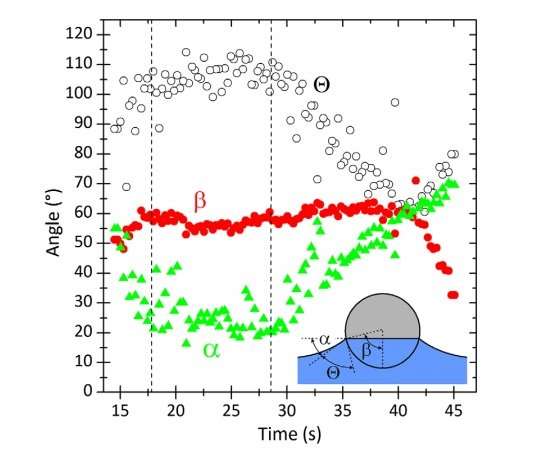August 27, 2018 feature
Physicists experimentally verify 40-year-old fluid equations

For decades, researchers have been using equations derived in the mid-1970s for a variety of fluid applications involving inks, foams, and bubbles, among other uses. These fundamental fluid equations describe how much force is required to pull a solid particle from a liquid surface. Although these equations have been experimentally confirmed for millimeter-sized particles, experimental confirmation in the micrometer regime has been lacking.
Aiming to fill this gap, researchers in a new study have, for the first time, simultaneously measured the capillary force on a single microparticle while imaging the shape of the liquid meniscus that forms underneath the particle, which tries to pull the particle back to the liquid. Their results experimentally verify the 1970s fluid equations for microparticles.
The researchers, led by Hans-Jürgen Butt at the Max Planck Institute for Polymer Research in Mainz, Germany, have published a paper on their experimental results in a recent issue of Physical Review Letters.
Particle behavior on liquid surfaces has many applications, and has been widely studied, at least for particles down to about 0.3 millimeters in diameter. As one of these macroparticles is pulled out of the liquid, a meniscus forms between the particle and liquid surface, creating a capillary force that tries to pull the particle back to the surface. At macroscopic scales, gravity also plays a significant role in pulling a particle back down to the liquid surface. Experiments have also shown that, as a macroparticle is being pulled up from the surface, it can slide around on the surface with the meniscus sliding underneath.
Things are different, however, at the microscale, where gravity is usually negligible compared to capillary forces. Since there have not been as many experiments with microparticles, many questions remain unanswered. Some of these open questions include determining how the capillary force and the shape of the meniscus are related, as well as whether microparticles can slide on the surface like macroscopic particles can.
In their experiments, the researchers glued a glass microparticle to the end of a cantilever on a microscope, and then slowly immersed the cantilever with the microparticle into a container of glycerol. Using advanced microscope techniques, the researchers simultaneously measured the capillary force and the contact angle between the microparticle and the meniscus as the microparticle was slowly lifted out of the fluid.
While the experimental results verified the fundamental fluid equations for microparticles in general, they also revealed some surprises. For instance, unlike for macroscopic particles, the contact line between a microparticle and the liquid surface is pinned down for most of the detaching process. Only in the final moments when the microparticle is about to detach does the particle slide around on the surface.
The researchers expect that the results will be useful for the many applications that involve capillary forces of microparticles at liquid surfaces, such as mineral flotation and the deinking of paper.
More information: Frank Schellenberger et al. "Detaching Microparticles from a Liquid Surface." Physical Review Letters. DOI: 10.1103/PhysRevLett.121.048002
Journal information: Physical Review Letters
© 2018 Phys.org





















